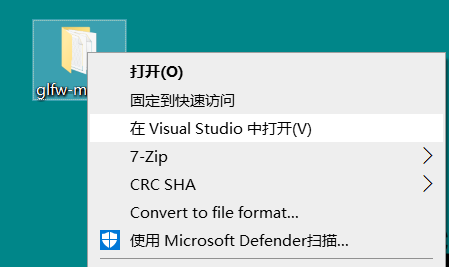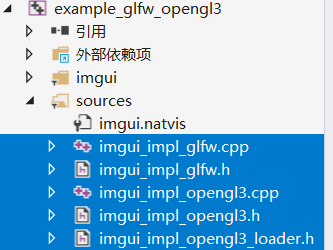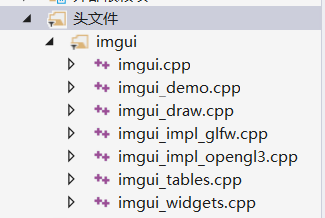【C++】從零開始的CS:GO逆向分析2——設定GLFW+IMGUI環境並建立透明視窗
2022-09-28 21:08:41
【C++】從零開始的CS:GO逆向分析2——設定GLFW+IMGUI環境並建立透明視窗
使用的環境:Visual Studio 2017,建立一個控制檯程式作為工程檔案
1.設定glfw
在github上下載GLFW https://github.com/glfw/glfw,github上的版本會比官網的高
選擇生成32位元專案

選擇全部重新生成,然後選擇 安裝->glfw
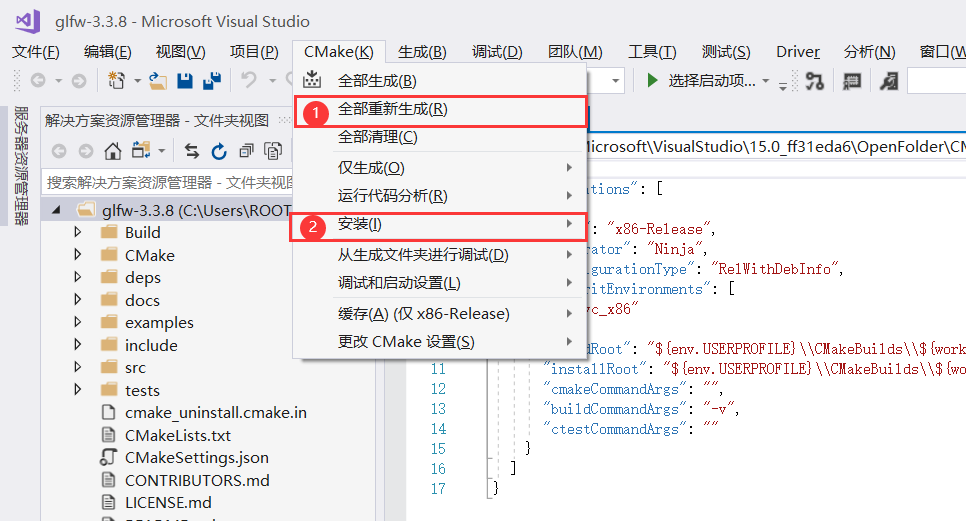
在下面的生成資訊可以看到需要的檔案生成的位置

開啟後,將include、lib資料夾複製到自己的工程資料夾
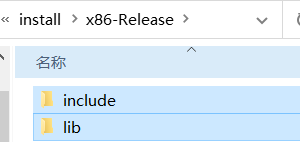
加入後設定自己的工程

專案屬性->c/c++ ->常規 下的附加包含目錄,輸入$(ProjectDir)include 新增
專案屬性->連結器->常規 下的附加庫目錄 ,輸入$(ProjectDir)lib 新增
專案屬性->連結器->輸入 下的附加依賴項 輸入 glfw3.lib;opengl32.lib; 新增
設定好後,用程式碼測試一下
#include <GLFW/glfw3.h> #pragma comment(lib,"glfw3.lib") int main(void) { GLFWwindow* window; /* Initialize the library */ if (!glfwInit()) return -1; /* Create a windowed mode window and its OpenGL context */ window = glfwCreateWindow(640, 480, "Hello World", NULL, NULL); if (!window) { glfwTerminate(); return -1; } /* Make the window's context current */ glfwMakeContextCurrent(window); /* Loop until the user closes the window */ while (!glfwWindowShouldClose(window)) { /* Render here */ glClear(GL_COLOR_BUFFER_BIT); /* Swap front and back buffers */ glfwSwapBuffers(window); /* Poll for and process events */ glfwPollEvents(); } glfwTerminate(); return 0; }
如果出現一個視窗則說明設定正確,設定有問題的可以檢查一下包含的目錄 是不是 自己複製到的目錄
2.設定IMGUI+glfw
開啟glfw
把資料夾裡的glew32s.lib複製到自己專案的lib資料夾裡
把GL資料夾複製到之前的include資料夾裡
在專案屬性->連結器->輸入 下的附加依賴項 中增加 glew32s.lib;
在專案屬性 ->c/c++ ->前處理器 的預處理定義下增加GLEW_STATIC
在範例程式碼中增加標頭檔案 #include<GL/glew.h>
在 if (!glfwInit()) return -1; 後增加程式碼 glewInit(); (增加的程式碼),成功執行則設定成功
下載IMGUI
在自己專案的include資料夾下新建一個imgui資料夾,將imgui-master中以下的檔案複製進去
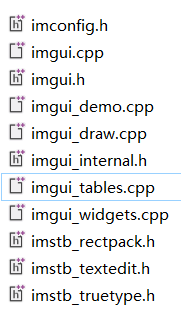
// Dear ImGui: standalone example application for GLFW + OpenGL 3, using programmable pipeline // (GLFW is a cross-platform general purpose library for handling windows, inputs, OpenGL/Vulkan/Metal graphics context creation, etc.) // If you are new to Dear ImGui, read documentation from the docs/ folder + read the top of imgui.cpp. // Read online: https://github.com/ocornut/imgui/tree/master/docs #include "imgui/imgui.h" #include "imgui/imgui_impl_glfw.h" #include "imgui/imgui_impl_opengl3.h" #include <stdio.h> #if defined(IMGUI_IMPL_OPENGL_ES2) #include <GLES2/gl2.h> #endif #include <GLFW/glfw3.h> // Will drag system OpenGL headers // [Win32] Our example includes a copy of glfw3.lib pre-compiled with VS2010 to maximize ease of testing and compatibility with old VS compilers. // To link with VS2010-era libraries, VS2015+ requires linking with legacy_stdio_definitions.lib, which we do using this pragma. // Your own project should not be affected, as you are likely to link with a newer binary of GLFW that is adequate for your version of Visual Studio. #if defined(_MSC_VER) && (_MSC_VER >= 1900) && !defined(IMGUI_DISABLE_WIN32_FUNCTIONS) #pragma comment(lib, "legacy_stdio_definitions") #endif static void glfw_error_callback(int error, const char* description) { fprintf(stderr, "Glfw Error %d: %s\n", error, description); } int main(int, char**) { // Setup window glfwSetErrorCallback(glfw_error_callback); if (!glfwInit()) return 1; // Decide GL+GLSL versions #if defined(IMGUI_IMPL_OPENGL_ES2) // GL ES 2.0 + GLSL 100 const char* glsl_version = "#version 100"; glfwWindowHint(GLFW_CONTEXT_VERSION_MAJOR, 2); glfwWindowHint(GLFW_CONTEXT_VERSION_MINOR, 0); glfwWindowHint(GLFW_CLIENT_API, GLFW_OPENGL_ES_API); #elif defined(__APPLE__) // GL 3.2 + GLSL 150 const char* glsl_version = "#version 150"; glfwWindowHint(GLFW_CONTEXT_VERSION_MAJOR, 3); glfwWindowHint(GLFW_CONTEXT_VERSION_MINOR, 2); glfwWindowHint(GLFW_OPENGL_PROFILE, GLFW_OPENGL_CORE_PROFILE); // 3.2+ only glfwWindowHint(GLFW_OPENGL_FORWARD_COMPAT, GL_TRUE); // Required on Mac #else // GL 3.0 + GLSL 130 const char* glsl_version = "#version 130"; glfwWindowHint(GLFW_CONTEXT_VERSION_MAJOR, 3); glfwWindowHint(GLFW_CONTEXT_VERSION_MINOR, 0); //glfwWindowHint(GLFW_OPENGL_PROFILE, GLFW_OPENGL_CORE_PROFILE); // 3.2+ only //glfwWindowHint(GLFW_OPENGL_FORWARD_COMPAT, GL_TRUE); // 3.0+ only #endif // Create window with graphics context GLFWwindow* window = glfwCreateWindow(1280, 720, "Dear ImGui GLFW+OpenGL3 example", NULL, NULL); if (window == NULL) return 1; glfwMakeContextCurrent(window); glfwSwapInterval(1); // Enable vsync // Setup Dear ImGui context IMGUI_CHECKVERSION(); ImGui::CreateContext(); ImGuiIO& io = ImGui::GetIO(); (void)io; //io.ConfigFlags |= ImGuiConfigFlags_NavEnableKeyboard; // Enable Keyboard Controls //io.ConfigFlags |= ImGuiConfigFlags_NavEnableGamepad; // Enable Gamepad Controls // Setup Dear ImGui style ImGui::StyleColorsDark(); //ImGui::StyleColorsLight(); // Setup Platform/Renderer backends ImGui_ImplGlfw_InitForOpenGL(window, true); ImGui_ImplOpenGL3_Init(glsl_version); // Load Fonts // - If no fonts are loaded, dear imgui will use the default font. You can also load multiple fonts and use ImGui::PushFont()/PopFont() to select them. // - AddFontFromFileTTF() will return the ImFont* so you can store it if you need to select the font among multiple. // - If the file cannot be loaded, the function will return NULL. Please handle those errors in your application (e.g. use an assertion, or display an error and quit). // - The fonts will be rasterized at a given size (w/ oversampling) and stored into a texture when calling ImFontAtlas::Build()/GetTexDataAsXXXX(), which ImGui_ImplXXXX_NewFrame below will call. // - Read 'docs/FONTS.md' for more instructions and details. // - Remember that in C/C++ if you want to include a backslash \ in a string literal you need to write a double backslash \\ ! //io.Fonts->AddFontDefault(); //io.Fonts->AddFontFromFileTTF("../../misc/fonts/Roboto-Medium.ttf", 16.0f); //io.Fonts->AddFontFromFileTTF("../../misc/fonts/Cousine-Regular.ttf", 15.0f); //io.Fonts->AddFontFromFileTTF("../../misc/fonts/DroidSans.ttf", 16.0f); //io.Fonts->AddFontFromFileTTF("../../misc/fonts/ProggyTiny.ttf", 10.0f); //ImFont* font = io.Fonts->AddFontFromFileTTF("c:\\Windows\\Fonts\\ArialUni.ttf", 18.0f, NULL, io.Fonts->GetGlyphRangesJapanese()); //IM_ASSERT(font != NULL); // Our state bool show_demo_window = true; bool show_another_window = false; ImVec4 clear_color = ImVec4(0.45f, 0.55f, 0.60f, 1.00f); // Main loop while (!glfwWindowShouldClose(window)) { // Poll and handle events (inputs, window resize, etc.) // You can read the io.WantCaptureMouse, io.WantCaptureKeyboard flags to tell if dear imgui wants to use your inputs. // - When io.WantCaptureMouse is true, do not dispatch mouse input data to your main application, or clear/overwrite your copy of the mouse data. // - When io.WantCaptureKeyboard is true, do not dispatch keyboard input data to your main application, or clear/overwrite your copy of the keyboard data. // Generally you may always pass all inputs to dear imgui, and hide them from your application based on those two flags. glfwPollEvents(); // Start the Dear ImGui frame ImGui_ImplOpenGL3_NewFrame(); ImGui_ImplGlfw_NewFrame(); ImGui::NewFrame(); // 1. Show the big demo window (Most of the sample code is in ImGui::ShowDemoWindow()! You can browse its code to learn more about Dear ImGui!). if (show_demo_window) ImGui::ShowDemoWindow(&show_demo_window); // 2. Show a simple window that we create ourselves. We use a Begin/End pair to created a named window. { static float f = 0.0f; static int counter = 0; ImGui::Begin("Hello, world!"); // Create a window called "Hello, world!" and append into it. ImGui::Text("This is some useful text."); // Display some text (you can use a format strings too) ImGui::Checkbox("Demo Window", &show_demo_window); // Edit bools storing our window open/close state ImGui::Checkbox("Another Window", &show_another_window); ImGui::SliderFloat("float", &f, 0.0f, 1.0f); // Edit 1 float using a slider from 0.0f to 1.0f ImGui::ColorEdit3("clear color", (float*)&clear_color); // Edit 3 floats representing a color if (ImGui::Button("Button")) // Buttons return true when clicked (most widgets return true when edited/activated) counter++; ImGui::SameLine(); ImGui::Text("counter = %d", counter); ImGui::Text("Application average %.3f ms/frame (%.1f FPS)", 1000.0f / ImGui::GetIO().Framerate, ImGui::GetIO().Framerate); ImGui::End(); } // 3. Show another simple window. if (show_another_window) { ImGui::Begin("Another Window", &show_another_window); // Pass a pointer to our bool variable (the window will have a closing button that will clear the bool when clicked) ImGui::Text("Hello from another window!"); if (ImGui::Button("Close Me")) show_another_window = false; ImGui::End(); } // Rendering ImGui::Render(); int display_w, display_h; glfwGetFramebufferSize(window, &display_w, &display_h); glViewport(0, 0, display_w, display_h); glClearColor(clear_color.x * clear_color.w, clear_color.y * clear_color.w, clear_color.z * clear_color.w, clear_color.w); glClear(GL_COLOR_BUFFER_BIT); ImGui_ImplOpenGL3_RenderDrawData(ImGui::GetDrawData()); glfwSwapBuffers(window); } // Cleanup ImGui_ImplOpenGL3_Shutdown(); ImGui_ImplGlfw_Shutdown(); ImGui::DestroyContext(); glfwDestroyWindow(window); glfwTerminate(); return 0; }
至此,環境設定完畢
需要補充幾個用得到glfw程式碼:
讓滑鼠事件透過建立的視窗
glfwWindowHint(GLFW_MOUSE_PASSTHROUGH, GLFW_TRUE);
讓視窗透明
glfwWindowHint(GLFW_TRANSPARENT_FRAMEBUFFER, true);
置頂視窗
glfwWindowHint(GLFW_FLOATING, true);
禁止更改視窗大小
glfwWindowHint(GLFW_RESIZABLE, false);
視窗最大化
glfwWindowHint(GLFW_MAXIMIZED, true);
設定沒有標題列
glfwSetWindowAttrib(window, GLFW_DECORATED, false);
刪除掉沒有用的程式碼,刪掉介面顯示的程式碼,設定視窗透明,設定視窗最大化,設定滑鼠通過,設定視窗不允許resize,就可以得到一個透明的視窗,即下面的程式碼
#include <stdio.h> #include<Windows.h> #include <GLFW/glfw3.h> #include "imgui/imgui.h" #include "imgui/imgui_impl_glfw.h" #include "imgui/imgui_impl_opengl3.h" #include "imgui/alifont.hpp" static void glfw_error_callback(int error, const char* description) { fprintf(stderr, "Glfw Error %d: %s\n", error, description); } int main() { glfwSetErrorCallback(glfw_error_callback); if (!glfwInit()) return 1; GLFWmonitor *monitor = glfwGetPrimaryMonitor(); //###########################設定視窗###########################
const char* glsl_version = "#version 130"; int Height = glfwGetVideoMode(monitor)->height; int Width = glfwGetVideoMode(monitor)->width; glfwWindowHint(GLFW_FLOATING, true); glfwWindowHint(GLFW_RESIZABLE, false); glfwWindowHint(GLFW_MAXIMIZED, true); glfwWindowHint(GLFW_TRANSPARENT_FRAMEBUFFER, true); glfwWindowHint(GLFW_MOUSE_PASSTHROUGH, GLFW_TRUE); //###########################設定視窗########################### GLFWwindow* window = glfwCreateWindow(Width, Height, "titile", NULL, NULL); if (window == NULL) return 1; glfwSetWindowAttrib(window, GLFW_DECORATED, false); //設定沒有標題列 ShowWindow(GetConsoleWindow(), SW_HIDE); glfwMakeContextCurrent(window); glfwSwapInterval(1); IMGUI_CHECKVERSION(); ImGui::CreateContext(); ImGuiIO& io = ImGui::GetIO(); (void)io; ImGui::StyleColorsDark(); ImGui_ImplGlfw_InitForOpenGL(window, true); ImGui_ImplOpenGL3_Init(glsl_version); while (!glfwWindowShouldClose(window)) { glfwPollEvents(); glClear(GL_COLOR_BUFFER_BIT); ImGui_ImplOpenGL3_NewFrame(); ImGui_ImplGlfw_NewFrame(); ImGui::NewFrame(); ImGui::Render(); int display_w, display_h; glfwGetFramebufferSize(window, &display_w, &display_h); glViewport(0, 0, display_w, display_h); ImGui_ImplOpenGL3_RenderDrawData(ImGui::GetDrawData()); glfwSwapBuffers(window); } // Cleanup ImGui_ImplOpenGL3_Shutdown(); ImGui_ImplGlfw_Shutdown(); ImGui::DestroyContext(); glfwDestroyWindow(window); glfwTerminate(); return 0; }
至此,已經設定好了glfw+imgui的環境,並且建立了透明視窗,下一章用第一篇裡的偏移值做點事
